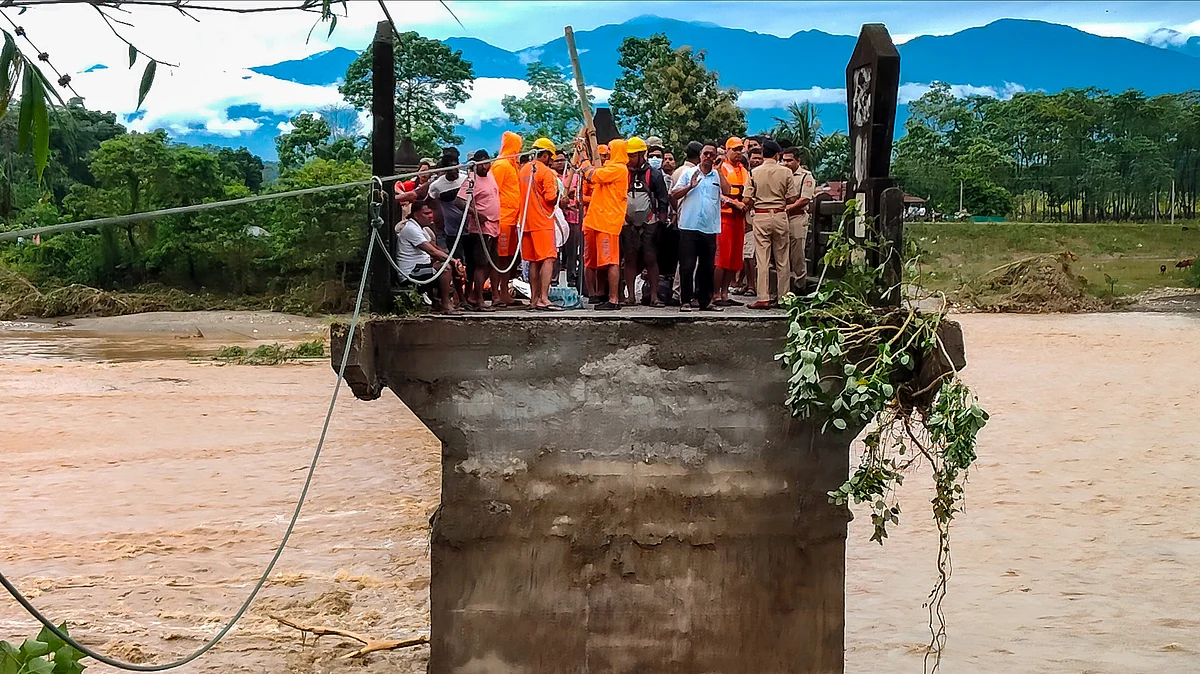Darjeeling drowns in grief: Landslides claim 23 lives amid relentless rains
Hundreds of tourists stranded as torrential rains lash the hills since Saturday night

The misty calm of Darjeeling gave way to chaos on Sunday, 5 October, as relentless downpours tore through its emerald slopes, triggering deadly landslides across the hills and neighbouring Jalpaiguri, leaving at least 23 dead in one of the region’s worst disasters in years.
The deluge swept away homes, buried roads under debris, and left hundreds of tourists stranded in the picturesque but now devastated hill region, officials confirmed.
According to data compiled by the National Disaster Response Force (NDRF) and the district administrations of Darjeeling and Jalpaiguri, fatalities were reported from Sarsaly, Jasbirgaon, Mirik Basti, Dhar Gaon (Mechi), Mirik Lake area, and Nagrakata.
The NDRF said 18 deaths occurred in Darjeeling district alone — 11 in Mirik, the worst-hit area, and seven in the Darjeeling subdivision, including Jorebunglow, Sukia Pokhri, and Sadar Police Station areas. Another five bodies were recovered from Nagrakata in Jalpaiguri.
“The total number of deaths reported so far is 23, spanning Mirik, Darjeeling, and Jalpaiguri,” an NDRF official said.
North Bengal development minister Udayan Guha described the situation as “alarming,” saying the death toll, officially 20 till evening, was likely to rise as rescue operations continued.
Anit Thapa, chief executive of the Gorkhaland Territorial Administration (GTA), said landslides had been reported from 35 locations across the Darjeeling hills, calling it the region’s worst disaster since 2015, when nearly 40 people died.
Entire slopes have collapsed, highways lie buried under thick mud, and communication lines have snapped. The Mirik–Sukhiapokhri road, a vital lifeline for several hill hamlets, remains completely blocked.
Hundreds of tourists who had flocked to the hills for Durga Puja and post-festival holidays found themselves trapped as torrential rain pounded the region from Saturday night. Families from Kolkata, Howrah, and Hooghly, staying in Mirik, Ghoom, and Lepchajagat, have been confined indoors amid continuous rain and roadblocks.
Road connectivity across Darjeeling and North Sikkim is severely affected, with an iron bridge linking Siliguri to the Mirik–Darjeeling route damaged, cutting off access to the area.
Rescue teams of the NDRF, State Disaster Response Force (SDRF), and civil defence have been deployed, with temporary relief camps set up in coordination with NGOs. Several families from Mirik have been shifted to safer areas, while dozens of people were pulled out alive from debris in Dhar Gaon and Nagrakata.
Chief minister Mamata Banerjee convened a high-level meeting at the state secretariat Nabanna, opened a 24x7 control room, and announced that she would visit North Bengal on Monday (October 6) to review the situation.
“The situation is grave. Due to incessant rain in Bhutan, water overflowed into North Bengal. Natural calamities like this are beyond our control,” Banerjee said, adding that over 300 mm of rainfall was recorded within 12 hours. She also announced compensation for the victims’ families and assured stranded tourists that the government would ensure their safe return.
Congress president Mallikarjun Kharge and Rahul Gandhi also expressed grief and urged the Centre to provide immediate assistance to the state.
"Deeply concerned about the devastating floods in West Bengal and Sikkim, especially in the Darjeeling and North Bengal regions, where several people have lost their lives, and a bridge has also tragically collapsed. My deepest condolences to the bereaved families. Expect the victims to be adequately and promptly compensated," Kharge said on X.
Prime Minister Narendra Modi expressed condolences, calling the situation in Darjeeling “deeply distressing”.
“Deeply pained by the loss of lives due to a bridge mishap in Darjeeling. The situation in the region is being closely monitored in the wake of heavy rains and landslides,” he said on X (formerly Twitter).
Darjeeling BJP MP Raju Bista has written to the chief minister, requesting that the calamity be declared a “state-level disaster.”
The India Meteorological Department (IMD) has issued a red alert for Cooch Behar and Jalpaiguri, and an orange alert for Darjeeling, warning of more rain and landslides due to saturated soil.
Sunday’s tragedy recalls the region’s past calamities — the 1968 deluge, which killed nearly 1,000 people, and the 2015 slides that claimed 40 lives. From the 1899 Darjeeling landslide to the Ambootia disaster of 1968, the fragile Himalayan slopes have repeatedly borne the brunt of nature’s fury.
The state government has placed emergency control rooms in Siliguri, Darjeeling, and Jalpaiguri on high alert, with additional disaster response teams on standby as rains continue to lash the hills.
With PTI inputs
Follow us on: Facebook, Twitter, Google News, Instagram
Join our official telegram channel (@nationalherald) and stay updated with the latest headlines
